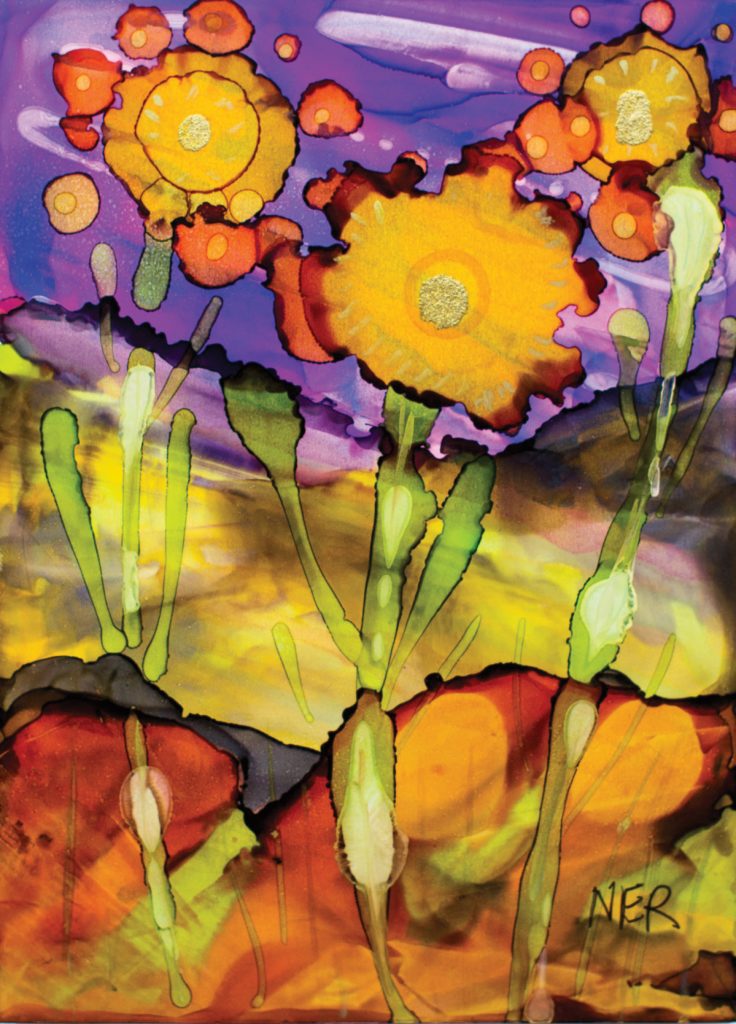
“They tell you,” she says.
Portrait by Karin Strickland
“You could say I’m well rounded,” says Nancy E. Richards. “Or you could say I’m a dabbler.” Since the ’70s, Richards has experimented with pastels, watercolors, oils, and acrylics. She’s made pottery and she’s done silk painting, gouache, jewelry making, glass-bead design, and printmaking. But for the past five years, she’s focused primarily on painting in alcohol inks.
Richards took a class at John C. Campbell Folk School to learn about the trending medium. Using pigments suspended in alcohol, the artist paints on nonporous surfaces — aluminum, glass, ceramic tile, or colored synthetic Yupo paper that has a surface similar to plastic. “The inks blend together in fluid, unexpected ways,” explains Richards. When the alcohol evaporates, it leaves vivid pigments on the surface in what she calls “luminous patterns.”

Because the inks are transparent, they can be layered to overlap color and build visual depth and texture. There are also metallic alcohol inks that contribute shimmer and shine. Sometimes Richards paints on a vertical surface and lets the ink pool. Then she hits it with a blast of pressurized air from a spray can to make it bloom. Or she will paint on an upright surface at an easel, and let the inks drip and flow with the pull of gravity.
Alcohol-ink painting is not for those who want rigid structure.
“I’m not real big on the idea of control. That’s not for me. I’m not a hyperrealist and I don’t want to be a draftsman. For me it’s more expressive. More spontaneous. The line details and color blends are something that you can’t predict because they flow together and don’t stay together. There are always surprises — sometimes horrific, but mostly good ones.”

Alcohol evaporates rapidly, leaving little time to explore, compose, and contemplate. The inks may even dry before they drip the whole way down a board on Richards’ easel. Despite the fleeting window of working time, however, the rather paradoxical medium does offer second chances and virtually unlimited do-overs. Until the top surface of the paintings are sealed for permanence, the ink is still workable. The painter just adds rubbing alcohol to the dried ink and it again becomes fluid. One can paint with it, play with it, or remove all of it and start again.
Of course, this begs the question, how does the artist know when to stop? “The piece tells you whether or not it’s finished,” according to Richards.

For inspiration, she turns to nature and neighbors. “I love color and light, and it seems that both people and the natural world have a radiance and light that comes from within.”
Nancy E. Richards, Brevard. The artist is represented by Number 7 Arts (2 West Main St, Brevard, number7arts.org) and at Changes in Altitude (10754 Greenville Hwy., Cedar Mountain, 828-884-4453). Her work will be exhibited during July at the Hollingsworth Gallery (147 East Main St., Brevard). For more information, see nancyerichards-artist.com and on Facebook: Nancy E. Richards — Artist.